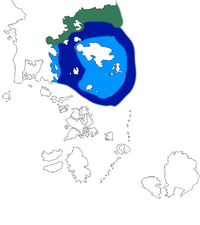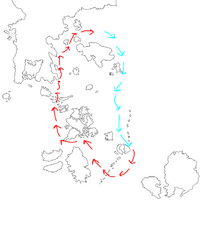Asterhaf
Asterhaf (literally, "The Eastern Sea") is a vast oceanic region located east of Scandera and northwest of Asterland. Known by various names including Nardsja, Svarthaf, Kakto Dour, and Ishashi'mo (meaning "The Northern Sea," "The Black Ocean," "The Northern Ocean," or the "Sahsi/Scanderan Sea"), the area is considered federal waters by the Absolute Royal Federation. Although the Federation does not assert as stringent a claim over this ocean as it does over the entire Vattnafalten in the south, and it does not enforce the entire region as within its exclusive economic zone (EEZ).
Asterhaf is bounded by Scandera, notably Imeriata, Vedian, and the northern ice plains to the east, and centrally surrounds Asterland and Salywa. The southern reaches include notable locations such as the island of Dragon Grave, Taranaka, and Salmo, with the far north defined by the Cairn Shore.
The sea is distinguished by its profound central depth, a result of tectonic plates gradually separating Asterland from Scandera. This geologic activity not only fosters a deep-sea environment but also leads to frequent volcanic activity, contributing to the formation of several small island chains. These islands are primarily inhabited by Scanderans, Scanderianized natives, Giels, and other ethnic groups collectively referred to as "Havsavalk" by federal authorities. Due to historical Scanderianization, these groups have either assimilated or been replaced by Scanderan settlers over the centuries.
Economically and militarily, the region is crucial, serving as a major transport hub connecting Asterland, Salywa, and Scandera. Although not as heavily utilized as the Vattnafalten, the sea has historically been vital for regional trade, especially the routes from Asterland to the Scanderan Northern Ice Plains and down to Scandera proper. Today, industries such as fishing and whaling remain significant, complemented by emerging oil drilling activities. Strategically, the region hosts substantial naval bases for the Federal and Royal fleets, ensuring control and providing a strategic point from which to defend the southern territories.
Geography
The region's geography is influenced by the divergent continental drift between the southern Scanderan and Asterland shelves, which has created a notably deep ocean. Additionally, the warm Vattnafalt Stream moderates the climate, causing heavy rainfall on the eastern Scanderan coast and contributing to the region's temperate and Arctic rainforests. Large meltwater runoffs from the islands enrich the sea with minerals, fostering annual algae blooms that support extensive marine life.
The sea is divided into five distinct areas: the northern kelp forests, the dense pine mangroves of eastern Scandera, the shallows of Asterland, the volcanic islands, and the deep black sea. These regions are interconnected, facilitating large-scale migrations of marine wildlife.
Scanderan Coast
This extensive coastal area features kelp forests and pine mangroves, hosting a biodiverse array of species, including fish, seals, walruses, cetaceans, bears, and semi-aquatic mammals. Northern sea lizards are also present, though in smaller numbers compared to the southern Vattnafalten.
The Cairn shore
At the extreme north, the "Cairn Shore" or "Brasstrand" is a cold, rocky landscape dominated by a massive kelp forest. It supports a rich ecosystem of walruses, dolphins, seals, small whales, and various other marine species. Historically, it has been home to several civilizations, including ancient pyramid builders and cairn builders, known for their necromantic practices, which led to their eventual demise at the hands of Scanderans. The modern population is somewhat Scanderianised but they also keeps a lot of traditions and languages of their Cairn builder forebears.
Eastern shallows
Surrounding Asterland, this area includes shallow sandbanks, seagrass meadows, and kelp forests, and lacks the profound depths found in the central sea.
Islands
The islands between Scandera and Asterland are volcanic in nature. Their fertile soils support birch forests, and seasonal meltwaters contribute to significant algae blooms, attracting massive schools of fish and their predators.
Deep Sea
Characterized by its depth, the deep sea region is the site of significant volcanic activity and hosts large marine fauna, including kraken squids and sea dragons. Although modern navigation is safer, the area remains treacherous due to its predatory inhabitants.
Biology
Fish
Sea Lizards
Cetaceans
Fish
Fish are a fundamental component of the Asterhaf ecosystem and play a crucial role in the diet of nearly every animal living in or around the sea. They constitute a significant portion of the region's ecological diversity and occupy almost every ecological niche, with the exception of the largest apex predators, such as sea dragons, whales, and krakens.
Fish in the Asterhaf range in size from very small species that feed on algae and plankton to medium-sized fish that are both predators and herbivores. The largest fish, including both predatory species and herbivores, can rival smaller whales in size. Sharks and other large predatory fishes are known to hunt and feed on seals and smaller whales.
Fish are integral to the ecosystem, and almost every other clade of animals in the region relies on them in some capacity.


